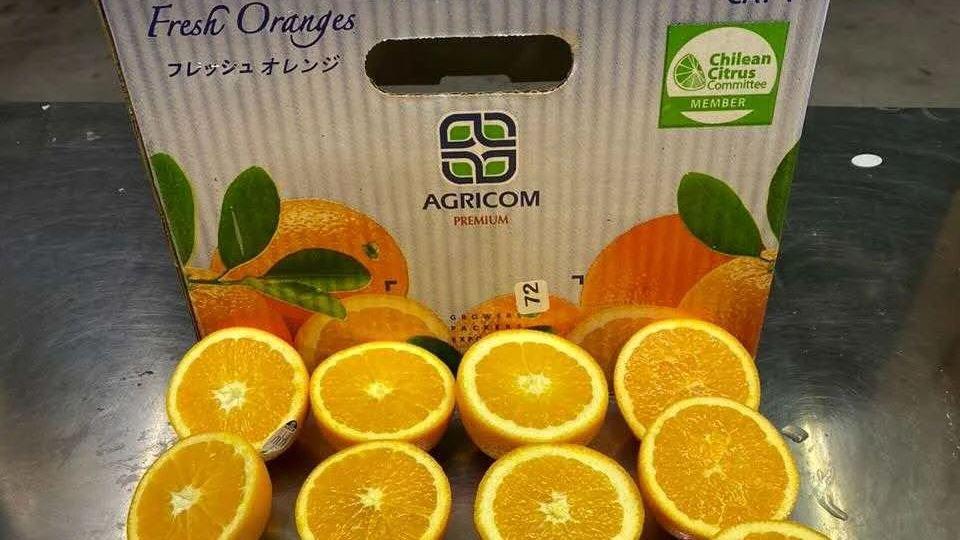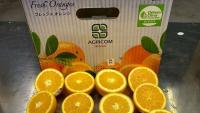You are here
Back to topFirst Shipment of Chilean Navel Oranges Arrives at Jiangnan Market

Produce Report has learned that the first ever shipment of Chilean navel oranges recently arrived at Guangzhou’s Jiangnan Fruit and Vegetable Wholesale Market. This batch of oranges was imported by Shenzhen Yi Guo Agriculture Products Co. Ltd. and follows on from the first ever shipment of Chilean lemons and clementines, which reached Shanghai on June 29.
The oranges in this shipment were of the Fukumoto variety. Originating in Japan’s Wakayama Prefecture, Fukumoto oranges are a high-grade early-maturing variant of Washington navel oranges that are well suited for relatively dry areas with ample sunlight and large temperature differences between day and night. Fukumoto oranges were introduced into China in 1981 and are still currently grown there in limited quantities. For instance, the harvest season for Fukumoto oranges in the Chongqing area falls toward the middle and end of November.
The Fukumoto variety has been well received by consumers owing to its pleasing exterior and quality interior, with U.S.-grown Fukumoto oranges proving particularly popular in Hong Kong and Japan. Fukumoto oranges are exceptionally suitable for fruit baskets and are often sold as gifts.
The entry of Chilean navel oranges into the Chinese market is the result of over 20 years of discussion between Chinese authorities and Chile’s Ministry of Agriculture. In May of this year, the two countries reached an agreement to allow the import of Chilean citrus into China following inspections of Chilean orchards by Chinese quarantine experts in August 2019. The permitted citrus species include mandarins (Citrus reticulata and its hybrids), grapefruit (Citrus paradisi), oranges (Citrus sinensis) and lemons (Citrus limon).
Chilean Agriculture Minister Antonio Walker noted that citrus exports to China will be beneficial for the diversification of the country’s agricultural sector, particularly for the Coquimbo, Valparaíso and Santiago Metropolitan regions, which account for 36.5%, 31.2% and 16.1% of Chile’s citrus exports, respectively.
The supplier behind this shipment was Agricom, which is Chile’s largest lemon exporter and the world’s biggest avocado exporter. Agricom was founded in 1980 and has partnerships with Mexico-based Aztecavo and U.S.-based Giumarra Agricom International. The company’s business operations encompass the production and packing of fruit in Chile and their export around the globe. Agricom’s main navel orange supply season typically lasts between June and November.
On the Chinese side, the importer was Shenzhen Yi Guo Agriculture Products Co. Ltd., which specializes in high-quality fruit imports and sales, including such high-end fruits as grapes from i-Fruit Limited, Malaysian Musang King durians, Australian mangos, top-grade New Zealand cherries and Breeze apples.
Global demand for citrus has risen this year as a result of the COVID-19 pandemic, with prices increasing during the early months before returning to normal. Chile is the second largest exporter of citrus in the Southern Hemisphere, with sales continuing to rise this year. As of July 5, Chile’s citrus sales had increased by 47.6% relative to the same period of last year. Chile’s citrus export season began in mid-May, and exports were expected to have reached 30,000 tons by the beginning of July, of which a large proportion went to the U.S. market.
China’s citrus import market is not looking as vibrant as last year. Although transportation has gradually picked up, shipment times have witnessed some delays with knock-on effects on citrus imports. In particular, the Chinese market for high-end citrus has been slowing down since June, with only low volumes of Australian oranges being imported. Owing to reduced demand from the food service industry, the import volume of Egyptian oranges, which are often used for juicing, has also decreased.
Image: Shenzhen Yi Guo Agriculture Products Co. Ltd.
This article was translated from Chinese. Read the original article.












Add new comment